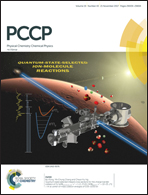Prediction of topological crystalline insulators and topological phase transitions in two-dimensional PbTe films†
Abstract
Topological phases, especially topological crystalline insulators (TCIs), have been intensively explored and observed experimentally in three-dimensional (3D) materials. However, two-dimensional (2D) films are explored much less than 3D TCIs, and even 2D topological insulators. Based on ab initio calculations, here we investigate the electronic and topological properties of 2D PbTe(001) few-layer films. The monolayer and trilayer PbTe are both intrinsic 2D TCIs with a large band gap reaching 0.27 eV, indicating a high possibility for room-temperature observation of quantized conductance. The origin of the TCI phase can be attributed to the px,y–pz band inversion, which is determined by the competition of orbital hybridization and the quantum confinement effect. We also observe a semimetal–TCI–normal insulator transition under biaxial strains, whereas a uniaxial strain leads to Z2 nontrivial states. In particular, the TCI phase of a PbTe monolayer remains when epitaxially grown on a NaI semiconductor substrate. Our findings on the controllable quantum states with sizable band gaps present an ideal platform for realizing future topological quantum devices with ultralow dissipation.



 Please wait while we load your content...
Please wait while we load your content...